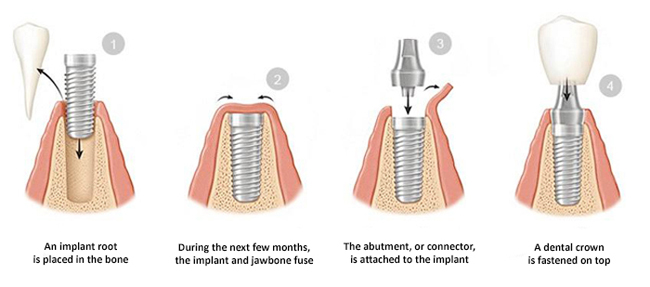A dental implant is an artificial tooth that mimics the structure of a natural tooth. An implant has three tooth-like components. And no other form of tooth replacement looks, feels, or functions better than an implant.
Dental Implant Components
A dental implant has three components:
- Root form – A post, usually made of titanium, is inserted in your jawbone.
- Abutment – An abutment, or connector, is attached to the root form and supports a dental crown.
- Dental crown – A crown replaces the white portion of your tooth—from the gumline up.
When Are Implants Used?
 Dental Implants - Monroe, LA - Dr. David Finley
Read Transcript
Dental Implants - Monroe, LA - Dr. David Finley
Read TranscriptThere are a number of different ways of using a dental implant to replace missing teeth. Some patients that have, say a denture and need to have that denture stabilized can have four or six little small what we call mini implants placed where a denture snaps onto that. Most of the time, patients need something a little bit more durable and longer lasting in that respect, and so there’s a lot of other different ways of placing implants in such a way that the patient can benefit.
For instance, a patient with dentures, you can place two implants in an arch and a patient can have a denture then that snaps on, but maybe up in the upper arch still has to have the palate covered by the denture because you have to have some suction to create retention. In that same patient if we place four implants in the upper arch, then we can make a denture that snaps on, but it’s shaped more like a horseshoe, and so the palate is not covered. So when they drink that hot coffee, they know it’s hot before it hits the back of the throat. It’s a real benefit for a patient that’s worn dentures all their lives because there’s taste buds in the palate that let us know what kind of food we’re eating or what kind of liquid we’re drinking.
Another way of solving patient’s denture-related problems and missing teeth would be some form of restoration that is placed on implants but doesn’t come out, and there’s two ways of doing that. One way is where we can place either four or six implants in the arch, and then create sort of a denture that is held in place by screws and only dentists can take it out.
Another way of doing dental implants would be placing more implants and doing more individual type of teeth which we’ve done all the time. You know, if you place eight or 10 implants in an arch, you can go back put crowns in all those and a person’s got what God intended them to have at the beginning. Obviously, if you’re missing a front tooth, we can put an implant in and in just a short period of a couple of months you’re back smiling the way you want to smile.
- Replace a single tooth or multiple missing teeth
- Support a dental bridge
- Stabilize dentures
Why Consider Dental Implants?
Dental implants have several advantages
- The implanted root form fuses with your jawbone and provides a solid anchor.
- No work is required on adjacent teeth.
- After you receive a dental crown or an arch of teeth, the results look and feel natural.
- Implants stimulate the jawbone and help prevent bone shrinkage and facial sagging.
Limitations of other forms of tooth replacement
Removable Partial Denture
A removable partial denture has a gum-colored base with replacement teeth embedded in it. It also has clasps that fit around your adjacent teeth to keep it in place. The hardware can be uncomfortable, and the attachments—if not hidden—can detract from your smile.
Dental Bridge
A dental bridge usually consists of three connected dental crowns. The replacement tooth is in the middle. And the crown on each end is placed over a tooth to serve as an anchor. Your anchor teeth must be reduced for the crowns to fit over them.
Complete Removable Dentures
A complete removable denture replaces an entire arch of teeth. The lower denture rests on your gums, and suction holds the upper denture in place. Dentures commonly slip around or fall out.
Implant Options
- Individual implants – Dr. Finley can replace each missing tooth with a dental implant.
- Snap-on dentures – Your denture base can snap onto two dental implants.
- Implant overdentures – Four to six implants can provide a solid anchor for your denture.
- All-On-4 dental implants – Four to six implants are used. The back implants are tilted to increase contact with the jawbone and avoid grafting.
Read our implant overdentures page for more information.
What’s the Process?
Dr. Finley completes every phase of the dental implant process in his office. But before you receive an implant, he will carefully review your medical and dental histories to ensure you’re a candidate for this treatment. If you are, he will complete the following steps:
- Use 3-D cone-beam imaging to scan your oral cavities and determine the optimal position for the implant roots
- Check your bone levels to determine if grafting is needed
- Place the implant in your jawbone
- Attach a temporary crown to the implant abutment. If you’re receiving implanted-supported dentures, temporary teeth will be attached to the implants.
- Place the permanent crown or arch of teeth after the implant and your jawbone fuse
- Check your bite and ensure you’re comfortable with the fit
- Permanently attach the crown or prosthesis
- Schedule follow-up visits to ensure the implant site is healthy and the restoration is functioning well
You Will Receive High-Quality Implants
Dr. Finley uses 3-D cone-beam technology. The three-dimensional images help avoid implant mistakes and promote a successful outcome in several ways:
 How Technology Improves Implants - Bayou Dental Group - Monroe, LA - Dr. David Finley
Read Transcript
How Technology Improves Implants - Bayou Dental Group - Monroe, LA - Dr. David Finley
Read TranscriptDental implants have always kind of been a mystery for a lot of dentists. Because for years, we were handcuffed with our technology in our ability to take radiographs. So it was very difficult for years for dentists to be able to place implants accurately because we didn’t really know what we were getting into until we got into the mouth.
But now, with the technology that we have, especially in this office. We have a 3D cone-beam radiograph. Which is, it’s a Galileo cone beam machine. Which takes a CT scan of the head. And a CT scan is a three-dimensional picture of everything in the mouth. And basically this machine takes 512 views at different angles and different perspectives within the mouth in about 14 seconds. And then it allows us to reconstruct the patient’s entire jaw on the computer. And so I’m able to go into the computer and actually virtually place an implant in a place in the mouth that I know if an implant’s gonna fit.
So now we can plan things ahead of time, and we can know exactly where we’re going, how we’re gonna get there, and what benefits the patient’s gonna have by having implants placed.
- Determine if you have enough jawbone to support dental implants or if bone grafting is needed
- Provide detailed views of your nerves, sinuses, and oral cavities to ensure they are not damaged during implant placement
- Ensure your implant is precisely placed and the crown looks natural at the gumline
If you would like to know if you’re a candidate for dental implants, call us to schedule an appointment for an exam or request an appointment online.






